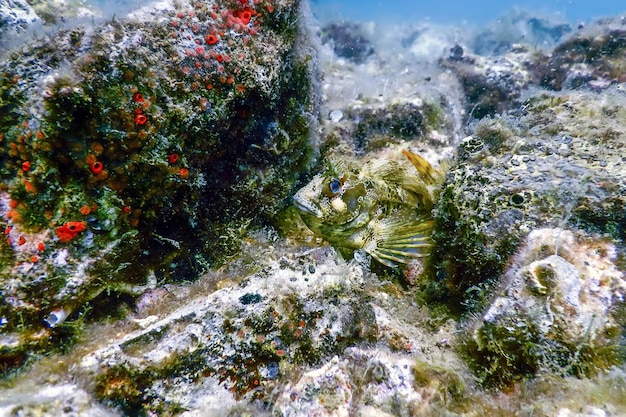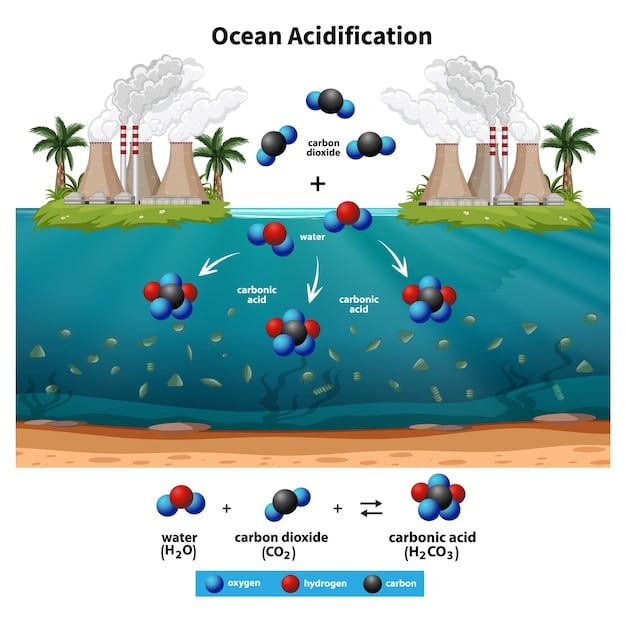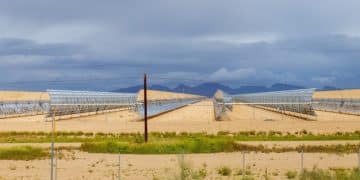Ocean Acidification: Threats to US Fisheries and Marine Ecosystems

Ocean acidification poses a significant threat to US fisheries and marine ecosystems, driven by increased carbon dioxide absorption in the ocean, leading to declining shellfish populations, coral reef degradation, and disruptions in the marine food web.
Discover the alarming effects of ocean acidification: What Are the Latest Threats to US Fisheries and Marine Ecosystems? Explore the latest research, impacts, and potential solutions in this in-depth analysis.
Understanding Ocean Acidification and Its Causes
Ocean acidification is an ongoing decrease in the pH of the Earth’s oceans, caused by the uptake of carbon dioxide (CO2) from the atmosphere. This process has profound implications for marine life and ecosystems around the world, especially in the United States.
The increasing levels of atmospheric CO2, primarily from human activities such as burning fossil fuels and deforestation, are absorbed by the ocean. This absorption leads to a series of chemical reactions that increase the concentration of hydrogen ions (H+) in seawater, consequently lowering the pH and making the ocean more acidic.

The Chemistry of Ocean Acidification
When CO2 dissolves in seawater, it forms carbonic acid (H2CO3). This acid then dissociates into bicarbonate ions (HCO3-) and hydrogen ions (H+). The increase in H+ ions leads to a decrease in pH, which is a measure of acidity.
One of the critical consequences of this process is the reduction in the availability of carbonate ions (CO32-). These ions are essential for marine organisms like shellfish and corals, which use them to build their skeletons and shells. As ocean acidity increases, the saturation state of carbonate minerals like aragonite and calcite decreases, making it more difficult for these organisms to build and maintain their structures.
Human Activities and CO2 Emissions
The primary driver of ocean acidification is the increase in atmospheric CO2 levels due to human activities. The burning of fossil fuels, such as coal, oil, and natural gas, releases large amounts of CO2 into the atmosphere. Deforestation also contributes to this increase, as trees absorb CO2 during photosynthesis, and their removal reduces the planet’s capacity to absorb CO2.
- Industrial processes, such as cement production, also release significant amounts of CO2.
- Agriculture contributes through land use changes and the use of fertilizers.
- Transportation, including cars, trucks, ships, and airplanes, is a major source of CO2 emissions.
Addressing the root causes of ocean acidification requires global efforts to reduce greenhouse gas emissions. This includes transitioning to renewable energy sources, improving energy efficiency, and implementing sustainable land-use practices.
In summary, ocean acidification is a direct consequence of increased CO2 levels in the atmosphere, driven by human activities. The chemical reactions that occur when CO2 is absorbed by the ocean lead to reduced pH levels and decreased availability of carbonate ions, posing significant threats to marine life.
Impacts on US Fisheries
Ocean acidification has far-reaching consequences for US fisheries, affecting a wide range of species and the economic stability of coastal communities. The declining pH levels in the ocean disrupt marine ecosystems, leading to decreased populations of commercially important fish and shellfish.
One of the most significant impacts of ocean acidification on US fisheries is the threat to shellfish populations. Shellfish, such as oysters, clams, and mussels, rely on carbonate ions to build their shells. As ocean acidity increases, it becomes more difficult for these organisms to form and maintain their shells, leading to weaker and more vulnerable structures.

Threats to Shellfish Populations
The impacts on shellfish populations are already being observed in several regions of the US. In the Pacific Northwest, oyster hatcheries have experienced significant losses due to ocean acidification. The increased acidity of the water makes it challenging for oyster larvae to develop strong shells, resulting in high mortality rates.
In addition to the Pacific Northwest, shellfish populations along the East Coast are also at risk. Studies have shown that increased acidity can affect the growth and survival of various clam and mussel species, which are important components of the local economies.
Effects on Fish Species
Ocean acidification can also affect fish species, although the mechanisms are different from those affecting shellfish. Fish can experience physiological stress due to changes in ocean pH, which can impact their growth, reproduction, and behavior.
For example, some fish species rely on their sense of smell to find food, avoid predators, and navigate. Ocean acidification can disrupt these olfactory cues, making it more difficult for fish to survive and reproduce.
- Changes in fish behavior can also have cascading effects on the entire marine ecosystem.
- Reduced growth rates and reproductive success can lead to decreased fish populations.
- The economic impacts of these declines can be significant for fishing communities.
The impacts of ocean acidification on US fisheries are multifaceted and far-reaching. The declining pH levels disrupt marine ecosystems, leading to decreased populations of commercially important fish and shellfish. These changes not only affect the environment but also have significant economic consequences for coastal communities.
The Vulnerability of Marine Ecosystems
Marine ecosystems, including coral reefs, kelp forests, and seagrass beds, are particularly vulnerable to the effects of ocean acidification. These ecosystems provide essential habitats for a diverse array of marine species and play a critical role in supporting marine biodiversity.
Coral reefs are among the most diverse and productive ecosystems on the planet. They provide habitat for approximately 25% of all marine species and support the livelihoods of millions of people through tourism, fisheries, and coastal protection. However, coral reefs are highly sensitive to changes in ocean chemistry, particularly ocean acidification.
Coral Reef Degradation
Corals use carbonate ions to build their skeletons, which form the structural foundation of coral reefs. As ocean acidity increases, it becomes more difficult for corals to build and maintain their skeletons, leading to slower growth rates and weaker structures.
In addition to reduced calcification, ocean acidification can also increase the susceptibility of corals to bleaching. Coral bleaching occurs when corals expel the symbiotic algae that live in their tissues, causing them to turn white and become more vulnerable to disease and death.
Impacts on Other Marine Habitats
Kelp forests and seagrass beds are also important marine habitats that are vulnerable to ocean acidification. Kelp forests provide habitat and food for a wide range of marine species, while seagrass beds support biodiversity and help to stabilize coastal sediments.
- Ocean acidification can affect the growth and survival of kelp and seagrass.
- Changes in ocean pH can impact the physiological processes of these organisms.
- The health of these habitats can have cascading effects on the entire marine ecosystem.
The vulnerability of marine ecosystems to ocean acidification underscores the need for urgent action to reduce greenhouse gas emissions and protect these critical habitats. Conservation efforts, such as marine protected areas and restoration projects, can also help to mitigate the impacts of ocean acidification and enhance the resilience of marine ecosystems.
Marine ecosystems are highly vulnerable to the effects of ocean acidification, with coral reefs, kelp forests, and seagrass beds being particularly at risk. The degradation of these habitats can have far-reaching consequences for marine biodiversity and the functioning of marine ecosystems.
Regional Impacts Across the US
Ocean acidification’s impacts vary across different regions of the US, depending on factors such as local oceanographic conditions, the types of marine ecosystems present, and the degree of human influence. Understanding these regional differences is essential for developing targeted strategies to mitigate the impacts of ocean acidification.
The Pacific Northwest is one of the regions most severely affected by ocean acidification in the US. The upwelling of deep, CO2-rich waters along the coast, combined with increased atmospheric CO2 levels, has led to particularly acidic conditions in this region.
Pacific Northwest: Oyster Hatchery Crisis
As mentioned earlier, oyster hatcheries in the Pacific Northwest have experienced significant losses due to ocean acidification. The increased acidity of the water makes it challenging for oyster larvae to develop strong shells, resulting in high mortality rates.
In addition to oysters, other shellfish species in the Pacific Northwest are also at risk. The economic consequences of these declines can be significant for the fishing communities that rely on these resources.
Gulf of Mexico: Hypoxia and Acidification
The Gulf of Mexico faces a combination of stressors, including ocean acidification and hypoxia (low oxygen levels). Hypoxia is often caused by nutrient pollution from agricultural runoff, which leads to algal blooms and subsequent oxygen depletion.
- The combined effects of ocean acidification and hypoxia can have devastating consequences for marine life.
- Fish and shellfish can experience physiological stress.
- The overall health and productivity of the Gulf of Mexico ecosystem can decline.
The regional impacts of ocean acidification across the US are diverse and complex. Understanding these differences is essential for developing targeted strategies to mitigate the impacts of ocean acidification and protect marine resources in different regions.
Ocean acidification is affecting various regions across the US in different ways. The Pacific Northwest faces severe threats to its shellfish industries, while the Gulf of Mexico grapples with the combined effects of acidification and hypoxia. Recognizing these regional nuances is crucial for devising effective mitigation strategies.
Mitigation and Adaptation Strategies
Addressing ocean acidification requires a combination of mitigation and adaptation strategies. Mitigation involves reducing the root causes of ocean acidification, primarily by decreasing greenhouse gas emissions. Adaptation focuses on helping marine ecosystems and communities cope with the impacts of ocean acidification that are already occurring.
The most effective way to mitigate ocean acidification is to reduce greenhouse gas emissions. This can be achieved through a combination of policies and actions at the international, national, and local levels.
Reducing Greenhouse Gas Emissions
Transitioning to renewable energy sources, such as solar, wind, and hydropower, is essential for reducing greenhouse gas emissions. Improving energy efficiency through better building design, transportation systems, and industrial processes can also help to decrease emissions.
In addition to reducing emissions, carbon capture and storage technologies can play a role in mitigating ocean acidification. These technologies involve capturing CO2 from industrial sources and storing it underground, preventing it from entering the atmosphere.
Adaptation Strategies for Marine Ecosystems
Adaptation strategies are needed to help marine ecosystems and communities cope with the impacts of ocean acidification. These strategies can include protecting and restoring coastal habitats, managing fisheries sustainably, and developing more resilient aquaculture practices.
- Protecting and restoring coastal habitats, such as coral reefs and seagrass beds, can help to buffer the impacts of ocean acidification.
- Implementing sustainable fisheries management practices can help to maintain healthy fish populations.
- Developing more resilient aquaculture practices can help to ensure a stable supply of seafood.
Effective mitigation and adaptation strategies are essential for addressing the challenges posed by ocean acidification. By reducing greenhouse gas emissions and implementing measures to protect and restore marine ecosystems, we can help to ensure a healthier future for our oceans and the communities that depend on them.
Mitigation and adaptation strategies are crucial for addressing ocean acidification. Reducing greenhouse gas emissions is the primary mitigation measure, while adaptation strategies focus on helping marine ecosystems and communities cope with the impacts that are already occurring.
The Role of Policy and Public Awareness
Policy and public awareness play a critical role in addressing ocean acidification. Effective policies can help to reduce greenhouse gas emissions, protect marine ecosystems, and promote sustainable practices. Increased public awareness can help to build support for these policies and encourage individuals to take action to address ocean acidification.
At the international level, agreements such as the Paris Agreement provide a framework for countries to reduce greenhouse gas emissions. However, more ambitious commitments and stronger enforcement mechanisms are needed to achieve the goals of the agreement.
International Agreements and National Policies
At the national level, policies such as carbon taxes, cap-and-trade systems, and renewable energy standards can help to reduce greenhouse gas emissions. Regulations to protect coastal habitats and manage fisheries sustainably can also contribute to mitigating and adapting to ocean acidification.
In addition to government policies, the private sector also has a role to play in addressing ocean acidification. Companies can reduce their carbon footprint, invest in sustainable practices, and support research and development of innovative solutions.
Increasing Public Awareness
Public awareness campaigns can help to educate people about the causes and consequences of ocean acidification. These campaigns can use a variety of media, including television, radio, social media, and educational programs, to reach a wide audience.
- Community-based initiatives, such as coastal cleanups and educational workshops.
- Engaging the public through citizen science projects.
- Encouraging individuals to reduce their carbon footprint.
Policy and public awareness are essential components of a comprehensive strategy to address ocean acidification. By implementing effective policies and raising public awareness, we can work together to protect our oceans and the communities that depend on them.
Policy and public awareness are vital for addressing ocean acidification. Effective policies can reduce greenhouse gas emissions and protect marine ecosystems, while increased public awareness can build support for these policies and encourage individual action.
| Key Point | Brief Description |
|---|---|
| 🌊 Rising Acidity | Ocean acidification is increasing due to CO2 absorption. |
| 🐚 Shellfish Threats | Shellfish struggle to build shells in more acidic conditions. |
| 🐠 Ecosystem Impact | Coral reefs and other ecosystems face degradation. |
| 🌱 Mitigation Needed | Reducing emissions is crucial for mitigating acidification. |
Frequently Asked Questions
What is ocean acidification?
▼
Ocean acidification is the ongoing decrease in the pH of the Earth’s oceans, caused by the uptake of carbon dioxide (CO2) from the atmosphere. This process makes the ocean more acidic, affecting marine life.
What are the primary causes of ocean acidification?
▼
The main causes include the burning of fossil fuels, deforestation, and industrial processes, all of which release large amounts of CO2 into the atmosphere, which is then absorbed by the ocean.
How does ocean acidification affect marine life?
▼
Ocean acidification makes it difficult for shellfish and corals to build their shells and skeletons. It can also disrupt fish behavior and harm marine ecosystems, reducing biodiversity and affecting food webs.
What can be done to mitigate ocean acidification?
▼
Mitigation involves reducing greenhouse gas emissions through transitioning to renewable energy, improving energy efficiency, and implementing carbon capture technologies. These efforts aim to lower CO2 levels in the atmosphere.
What adaptation strategies can help?
▼
In conclusion, ocean acidification: What Are the Latest Threats to US Fisheries and Marine Ecosystems? is a pressing issue that demands global attention. By reducing greenhouse gas emissions, implementing sustainable policies, and raising public awareness, we can protect our oceans and ensure a sustainable future for marine life.
Read more content





